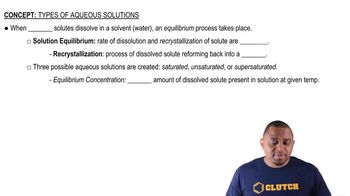An element X reacts with oxygen to form XO2 and with chlorine to form XCl4. XO2 is a white solid that melts at high temperatures (above 1000 °C). Under usual conditions, XCl4 is a colorless liquid with a boiling point of 58 °C. (b) Do you think that element X is a metal, nonmetal, or metalloid?
Ch.7 - Periodic Properties of the Elements
Chapter 7, Problem 66
Write balanced equations for the following reactions: (a) sulfur dioxide with water (b) lithium oxide in water (c) zinc oxide with dilute hydrochloric acid (d) arsenic trioxide with aqueous potassium hydroxide.
 Verified step by step guidance
Verified step by step guidance1
Identify the reactants: Arsenic trioxide (As2O3) and potassium hydroxide (KOH).
Determine the products: When arsenic trioxide reacts with a strong base like potassium hydroxide, it forms potassium arsenite (K3AsO3) and water (H2O).
Write the unbalanced chemical equation: As2O3 + KOH
ightarrow K3AsO3 + H2O.
Balance the equation by adjusting the coefficients to ensure the number of atoms for each element is equal on both sides of the equation. Start by balancing the arsenic (As) and oxygen (O) atoms, then adjust the potassium (K) and hydrogen (H) atoms.
Check the final balanced equation to ensure mass and charge are balanced.

Verified video answer for a similar problem:
This video solution was recommended by our tutors as helpful for the problem above.
Video duration:
4mWas this helpful?
Key Concepts
Here are the essential concepts you must grasp in order to answer the question correctly.
Balancing Chemical Equations
Balancing chemical equations involves ensuring that the number of atoms for each element is the same on both the reactant and product sides. This is based on the law of conservation of mass, which states that matter cannot be created or destroyed in a chemical reaction. To balance an equation, coefficients are adjusted in front of the chemical formulas, rather than changing the formulas themselves.
Recommended video:
Guided course

Balancing Chemical Equations
Acid-Base Reactions
Acid-base reactions typically involve the transfer of protons (H⁺ ions) between reactants. In this case, arsenic trioxide (As₂O₃) can react with potassium hydroxide (KOH), which is a strong base, to form a salt and water. Understanding the nature of the reactants and the products formed is crucial for predicting the outcome of the reaction.
Recommended video:
Guided course

Acid-Base Reaction
Solubility and Aqueous Solutions
In aqueous solutions, the solubility of compounds plays a significant role in determining the products of a reaction. Potassium hydroxide is soluble in water, dissociating into K⁺ and OH⁻ ions. Knowing the solubility of arsenic compounds helps predict whether a precipitate will form or if the reaction will proceed in solution, which is essential for writing the balanced equation.
Recommended video:
Guided course

Types of Aqueous Solutions
Related Practice
Textbook Question
Textbook Question
An element X reacts with oxygen to form XO2 and with chlorine to form XCl4. XO2 is a white solid that melts at high temperatures (above 1000 °C). Under usual conditions, XCl4 is a colorless liquid with a boiling point of 58 °C. (c) By using a sourcebook such as the CRC Handbook of Chemistry and Physics, try to determine the identity of element X.
Textbook Question
Write balanced equations for the following reactions: (a) boron trichloride with water (b) cobalt (II) oxide with nitric acid (d) carbon dioxide with aqueous barium hydroxide.
Textbook Question
Write a balanced equation for the reaction that occurs in each of the following cases: (a) Potassium metal is exposed to an atmosphere of chlorine gas.
1
views
